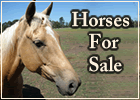

Pull Back
As far as tying at the barn, I don't tie a horse until they have already learned not to pull back. In order to teach them safely (so they don't break anything including themselves) I use Blocker Tie Rings all around my barn so they are not actually tied but if they pull back they feel a steady pressure but not so much pressure that they panic. If I can keep them from going into panic mode and keep them thinking by letting them pull back with some drag, which the Blocker Ring allows, then they will learn they didn't need to pull back in the first place.
Even before putting them on the tie ring I do lots of teaching the head down cue with my hands and then with the halter (see Six Keys to Harmony DVD for full and detailed demonstration of teaching head down cue). The reason a horse pulls back is when they walk around or step back while tied and suddenly feel pressure on the poll they don't know what to do with that pressure, feel trapped, panic, pull back and break something or injure themselves. A panic pullback can cause spinal misalignment and/or vertebrae separation. When panic takes over the horse doesn't care if they seriously hurt themselves all they can think of is survival by escape. Before a horse is tied I want them to know, without a doubt, what to do when they feel pressure from the poll. I spend allot of time applying small, steady downward and forward pressure with the halter and holding until the horse lowers the head or steps forward then releasing immediately. With this patient training they begin to learn that the place off of pressure is always down and forward, never up and back. I don't let a post do this job for me. It should be done in hand so you can give the immediate release and show the horse the successful answer to his question of "What am I supposed to do when I feel pressure on my poll?"

Ed Dabney is an internationally acclaimed clinician, presenting horsemanship and riding clinics all over the US and in Europe. In 2007, Ed was named Champion of the East Coast Trainer Challenge Series by Equine Extravaganza. Ed was honored to have been selected by the University of Georgia to teach their senior level Young Horse Training course.
His training articles have appeared in many major national magazines. Ed produces instructional videos and the “Gentle Horsemanship” TV program which has been seen on RFD-TV.
Ed's blending of natural horsemanship and classical equitation has made an indelible mark with students all across the United States and now also in Europe, drawing the attention of serious riders searching for the lightest touch and the deepest connection with their horses irrespective of breed or discipline.


